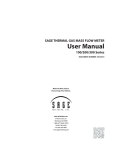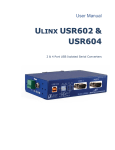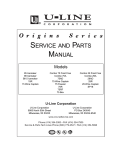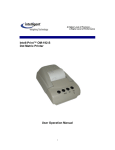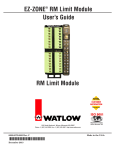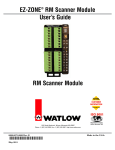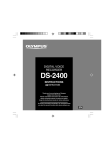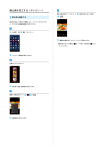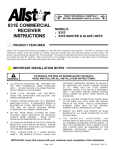Download Sage Service Manual Rev 2
Transcript
Sage Service Manual-Rev 2 1.0 Remote Wiring Issues Page 2 2.0 Common Diagnostics Page 4 3.0 Installing / using Addresser Page 8 3.1 SAGE ADDRESSER TECHNICAL ASSISTANCE Page 8 3.2 Sage Addresser Common Installation Difficulties Page 8 4.0 Sage Addresser Typical Printout (Version 3.14) Page 11 5.0 MODBUS Prime Registers Page 12 6.0 MODBUS TROUBLESHOOTING GUIDE Page 15 Sage Service Manual-Rev 2 Pg 1 of 16 Sage Metering, Inc / 8 Harris Ct / Building D1 / Monterey, CA 93940 / 866-677-SAGE / 831-242-2030 / Fax 831-655-4965 / www.sagemetering.com Sage Service Manual-Rev 2 1.0 Remote Wiring Issues The following chart describes the symptoms that will be seen with various open wires or incorrect wiring relative to remote style meters Troubleshooting Remote Wiring Issues mW Temperature Normal reading > 60 "80F" or "27C" Full Scale Reading > 700 "80F" or "27C" Jbox Wiring Normal Fault Short between 1 & 2 removed 60 "80F" or "27C" J-Box Pin 1 Blue Open 60 "80F" or "27C" 1&2 Internally shorted Pin 2 Green Open Pin 3 Red Open Short between 4 & 5 removed J-Box Pin 4 Orange Open 4&5 Internally shorted Flow 0 6300 Response to flow Yes Yes 0 0 Yes Yes 60 "80F" or "27C" 0 Yes 0 183 + 1400 + "80F" or "27C" "-201F" or "-129C" "-201F" or "-129C" 0 240 + Full Scale No Yes No Pin 5 Black Open 180 + "-201F" or "-129C" 240 + Yes Pin 6 SAB Wiring Pin 1 Pin 2 Pin 3 Pin 4 Pin 5 Pin 6 White Normal Red Green Blue White Black Orange Open 600 + "1434F" or "779C" Full Scale No Open Open Open Open Open Open 0 60 60 580 190 1600 "80F" or "27C" "80F" or "27C" "80F" or "27C" "1434F" or "779C" "-201F" or "-129C" "-201F" or "-129C" 0 0 0 Full Scale 240 + 0 No Yes Yes No Yes No Sage Service Manual-Rev 2 Pg 2 of 16 Sage Metering, Inc / 8 Harris Ct / Building D1 / Monterey, CA 93940 / 866-677-SAGE / 831-242-2030 / Fax 831-655-4965 / www.sagemetering.com Sage Service Manual-Rev 2 J-Box 1&2 Internally shorted J-Box 4&5 Internally shorted J-Box 1&2 Internally shorted J-Box 4&5 Internally shorted Jbox Wiring Normal Miss wired Pin 1 Blue Red Pin 2 Green Green Pin 3 Red Blue Pin 4 Orange Orange Pin 5 Blk Black Pin 6 SAB Wiring Pin 1 Pin 2 Pin 3 Pin 4 Pin 5 Pin 6 Jbox Wiring White Normal Red Green Blue White Black Orange Normal White 30 91 "80F" or "27C" Full Scale No 18 0 + "-201F" or "-129C" 240 + Yes Red Green Blue White Black Orange Pin 1 Blue Blue Pin 2 Green Green Pin 3 Red Red Pin 4 Orange White Pin 5 Black Black Pin 6 SAB Wiring Pin 1 Pin 2 Pin 3 Pin 4 Pin 5 Pin 6 White Normal Red Green Blue White Black Orange Orange Red Green Blue White Black Orange Sage Service Manual-Rev 2 Pg 3 of 16 Sage Metering, Inc / 8 Harris Ct / Building D1 / Monterey, CA 93940 / 866-677-SAGE / 831-242-2030 / Fax 831-655-4965 / www.sagemetering.com Sage Service Manual-Rev 2 2.0 Common Diagnostics SYMPTOM: Display failure, or pixels extremely dim. CORRECTIVE ACTION: Contact Factory. Certain types of failures are under long term warranty. Please note that the 4-20 mA will still function normally. SYMPTOM: Display fading, or partially fading. CORRECTIVE ACTION: a) Some fading, particularly with those characters that are lit up most frequently, is normal. The flow meter will continue to function properly, and flow meter accuracy and outputs will not be affected. b) In extreme cases, contact the factory for display replacement. c) Note, in late 2009, the Sage Prime was modified to incorporate a built-in photocell. The purpose of the photocell is to adjust the display brightness with ambient lighting. The brighter the surrounding lighting conditions, the brighter the display. Lower ambient lighting conditions, such as a factory environment, will dim the display. The display will be dimmest if operated in low ambient lighting, or at night. The photocell circuit is designed to extend the life of the display, and to minimize fading. d) Note, in early 2010, a further enhancement was added to further extend the life of the display. The above mentioned built-in photocell also senses motion which automatically switches display from Screen Saver mode to Normal mode. SYMPTOM: Erratic Readings. POSSIBLE CAUSES: If a large Motor or Generator or Variable Frequency Drive (VFD) is nearby the enclosure, it may be inducing sufficient analog noise into the circuitry to temporarily corrupt the data. SUGGESTED CORRECTIVE ACTION: a) If a Power-Restart temporarily solves the problem, than it is likely that the source of the noise was the problem. b) To prevent subsequent problems, if a Remote Style Meter, move the enclosure as far away as possible from the source (the Motor or VFD). c) If an Integral Style Meter, mount the meter in a different location (further from the source) or move the source further from the meter. SYMPTOM: Erratic Readings on a Remote Meter. POSSIBLE CAUSE: In some cases, analog noise is induced into the Remote cable causing erratic, or climbing readings. SUGGESTED CORRECTIVE ACTION: a) Be sure the remote cable is installed in metal conduit and grounded on one end (in some cases, grounding both ends may be required). b) Also, avoid coiled cable, especially if not in metal conduit. c) Also, if extra cable exists, move the extra cable as far away as possible from any source of analog noise, such as large motors or VFDs. SYMPTOM: Meter reading zero continuously, or Full Scale continuously, or temperature reading is abnormally low (hundreds of degrees below zero). POSSIBLE CAUSES/SUGGESTED CORRECTIVE ACTION: a) It is likely that a wire is loose. But in rare cases, a sensor could fail (i.e., if a standard sensor, HT01 or HT02 sensor exceeds a process temperature of 450°F.) b) Check for continuity to be sure the wiring is making good contact at the terminals of the Junction Box. c) Also, to verify that the electronics and the sensor serial number are the same, note the following: The sensor’s serial number will come up upon power up, right after Initializing on the Display. If the serial number doesn't agree with the Junction Box labels, that would affect calibration (in other words, sensors and electronics are a matched pair—mixing them up will cause false readings). Also metal Serial Number Tags are fastened to both the electronics and the Junction Box. They must have identical Serial numbers. d) To check if a sensor has failed on a remote style meter, it is easy to use the Junction Box to do so. You must Power Down (shut off power), but you do not need to remove the probe from the pipe. Sage Service Manual-Rev 2 Pg 4 of 16 Sage Metering, Inc / 8 Harris Ct / Building D1 / Monterey, CA 93940 / 866-677-SAGE / 831-242-2030 / Fax 831-655-4965 / www.sagemetering.com Sage Service Manual-Rev 2 e) An Ohm Meter is required to check across the sensor leads of the Flow Sensor. Look at the drawing of the Junction Disconnect the red Box. wires on the Factory Side to isolate and measure the resistance. If the reading is infinity or a short, it means that sensor has failed. f) Now check the Temperature Sensor. Disconnect the white wires on the Factory Side to isolate and measure the resistance. If you have infinity or a short, it means that sensor is burned out. Note: Normally the sensors will read approximately 110 ohms at 70° F. At higher temperatures they should read a higher resistance, but both sensors should have a similar value. g) On integral style meters (SIP), there is no Junction Box. In that case, refer to the Prime Integral Terminals on page 19 and check the sensor wires. Remove the appropriate wires first (red pair for flow, then white pair for temperature). Measure their resistance. If reading infinity or short, it means that sensor has failed. SYMPTOM: Meter Railing (Pegging) or Reading High POSSIBLE CAUSES/SUGGESTED CORRECTIVE ACTION: a) Insufficient straight run (i.e. flow profile is disturbed, causing errors). b) Possible jet effect if upstream pipe is smaller than meter flow body or if valve is too close upstream to meter. c) Not following Probe Insertion Guideline. d) If sensor is inserted in reverse (“Upstream” mark is facing downstream) Meter may over-report (or under-report) by as much as 30%. e) If sensor is not aligned properly, with “Upstream” mark facing upstream, a rotation greater than ± 5 degrees may cause change in reading (greater than ± 5 degrees and less than ± 20 degrees causes meter to over-report; a greater rotation actually blocks the sensor, and causes meter to under-report). f) A downstream valve too close to the meter (flow may be reflecting back). g) Possibly caused by water droplets condensing out of gas stream (which generally causes output to spike; but if droplets are near continuous, output may rail). h) Meter is miswired, especially in Remote Style application. i) Possibly caused by water droplets condensing on inside of pipe wall, which roll down or hit sensor causing output to spike; but if droplets are near continuous, output may rail. Note: Recommend installation 45° from vertical Sage Service Manual-Rev 2 Pg 5 of 16 Sage Metering, Inc / 8 Harris Ct / Building D1 / Monterey, CA 93940 / 866-677-SAGE / 831-242-2030 / Fax 831-655-4965 / www.sagemetering.com Sage Service Manual-Rev 2 j) Possibly caused by water droplets condensing out of gas stream and filling the cavity containing the sensing elements (usually due to probes mounted below horizontal in saturated pipes). k) Sensor may be contaminated. Remove probe, wipe off or clean with a solvent. Reinsert. l) Using a different gas or gas mix than the meter was specified and calibrated for. m) If a Remote Style Meter (SRP), be sure Serial Numbers of Junction Box and Remote Electronics are identical (if not, errors in calibration are inevitable). To confirm, verify that Junction Box Serial Number Tag has identical Serial Numbers to Tag on Remote Enclosure. n) Meter may appear to be reading high if user is comparing Sage flow meter readings (SCFM) to an uncorrected volumetric device (ACFM). For example, at constant volume, a decrease in gas temperature will increase the mass flow (SCFM). That is completely normal. SYMPTOM: Reading Low POSSIBLE CAUSES: a) Insufficient straight run (i.e. flow profile is disturbed, causing errors). b) Poor flow profile Upstream (insufficient upstream straight run). c) Not following Probe Insertion Guideline. d) If sensor is inserted in reverse (“Upstream” mark is facing downstream) Meter may over-report (or under-report) by as much as 30%. e) If sensor is not aligned properly, with “Upstream” mark facing upstream, a rotation greater than ± 5 degrees may cause change in reading (greater than ± 5 degrees and less than ± 20 degrees causes meter to over-report; a greater rotation actually blocks the sensor, and causes meter to under-report). f) Sensor may be contaminated. Remove probe, wipe off or clean with a solvent. Reinsert. g) Using a different gas or gas mix than the meter was specified and calibrated for. h) If a Remote Style Meter (SRP), be sure Serial Numbers of Junction Box and Remote Electronics are identical (if not, errors in calibration are inevitable). To confirm, verify that Junction Box Serial Number Tag has identical Serial Numbers to Tag on Remote Enclosure. i) Meter may appear to be reading low if user is comparing Sage flow meter readings (SCFM) to an uncorrected volumetric device (ACFM). For example, at constant volume, an increase in gas temperature will lower the mass flow (SCFM).That is completely normal. j) On most models, the Totalizer will not start counting for 10 seconds after power up so any flow data will not be accumulated during this time. k) Insufficient power supply—most products require minimum 100 ma. Sage Service Manual-Rev 2 Pg 6 of 16 Sage Metering, Inc / 8 Harris Ct / Building D1 / Monterey, CA 93940 / 866-677-SAGE / 831-242-2030 / Fax 831-655-4965 / www.sagemetering.com Sage Service Manual-Rev 2 l) Excessive load on the 4-20 ma. (To check if problem is due to 4-20 ma output device, temporarily remove device, and observe if display reads as expected). SYMPTOM: Totalizer can take up to 10 seconds to update its reading when flow meter is first powered up, or a channel is changed. CORRECTIVE ACTION: None. This slight delay is completely normal. SYMPTOM: Display does not have power POSSIBLE CAUSE: Miss-wiring SYMPTOM: 4-20 mA output not tracking the flow rate display POSSIBLE CAUSE: a) In normal operation (Self Powered) B4 and B5 must be jumpered to supply power to loop. b) In Externally Powered mode, the jumper must be removed. Verify that 9 to 27 Volts DC is supplied to externally power the loop. Sage Service Manual-Rev 2 Pg 7 of 16 Sage Metering, Inc / 8 Harris Ct / Building D1 / Monterey, CA 93940 / 866-677-SAGE / 831-242-2030 / Fax 831-655-4965 / www.sagemetering.com Sage Service Manual-Rev 2 Installing / using Addresser 3.0 Addresser is a convenient software kit that includes Addresser software, as well as an optically isolated ULINX RS485 to USB converter. The Addresser is a READ/WRITE Program with drop-down menus for convenient user interface between your PC or laptop and the Modbus Terminals of the Sage Prime. Contact Sage for ordering information and instructions. 3.1 SAGE ADDRESSER TECHNICAL ASSISTANCE Visit our website at www.sagemetering.com and navigate to the Manuals/Download section (http://www.sagemetering.com/manual.htm). Click on the “Instructional Manuals & Technical Data” button. User name: sage; password: 7243737. Click on link “Click to View ADDRESSER Procedures” and/or “Click to View MODBUS Poll/PRIME Communications Setup Instructions”. 3.2 Sage Addresser Common Installation Difficulties Symptom: LabVIEW error message: Unable to locate the LabVIEW Run-Time Engine Possible Cause: If you have not installed VI Terminal software prior to installing the Addresser software, you will be missing the required Run Time Engine that is installed when installing VI Terminal. Symptom: When trying to run the Addresser program you get a LabVIEW error 8 Probable Cause: This happens most often with users that are running Windows 7 and possible Vista on their computer. This is a permission error, meaning you do not have the right to write files to your computer. See your computer Network Administrator to allow this permission Symptom: Addresser Error, Read Registers Failure: Possible Cause: a) The Slave ID or Mod Bus address of your meter is NOT hex 30. The Addresser is broadcasting to your meter on Mod Bus Address hex 30 as a default. You can click on the Stop button and then see: The Addresser can find the slave ID if you click on the Find Address button. Sage Service Manual-Rev 2 Pg 8 of 16 Sage Metering, Inc / 8 Harris Ct / Building D1 / Monterey, CA 93940 / 866-677-SAGE / 831-242-2030 / Fax 831-655-4965 / www.sagemetering.com Sage Service Manual-Rev 2 a. If you know what address your meter is set to, you can change the address that the Addresser is talking to by changing the address displayed in the Device Address window of the Addresser. b. If the Com Port the Addresser is connected to is different than what the Addresser thinks it is, you will need to determine what the correct Com Port is. i. Right click on the My Computer icon, then select Manage ii. Then select Device Manager followed by Ports (COM & LPT) to find the RS-485 Isolated Port Sage Service Manual-Rev 2 Pg 9 of 16 Sage Metering, Inc / 8 Harris Ct / Building D1 / Monterey, CA 93940 / 866-677-SAGE / 831-242-2030 / Fax 831-655-4965 / www.sagemetering.com Sage Service Manual-Rev 2 iii. When the Read Register Failure message comes up on the Addresser, click on the New Port button and then select the port you just identified. iv. The Addresser should now talk to your meter. b) The Baud rate and/or parity of your meter has been set to other than standard of 19200 Baud with Even Parity. a. You will need to activate the Addresser during the initialization period of the meter during startup. b. You should be able to communicate with the meter normally now. Symptom: Windows 7 permission error Possible Cause: Configuration settings need to be changed to allow the vi to remember what port is assigned a) Open the Program Files folder on your computer a. Highlight Addresser.ini or Configuration settings b. Right click, then select properties c. Select Security, then Edit d. Highlight Users, then change permissions to include Write e. Click Apply Sage Service Manual-Rev 2 Pg 10 of 16 Sage Metering, Inc / 8 Harris Ct / Building D1 / Monterey, CA 93940 / 866-677-SAGE / 831-242-2030 / Fax 831-655-4965 / www.sagemetering.com Sage Service Manual-Rev 2 4.0 Sage Addresser Typical Printout (Version 3.14) Sage Service Manual-Rev 2 Pg 11 of 16 Sage Metering, Inc / 8 Harris Ct / Building D1 / Monterey, CA 93940 / 866-677-SAGE / 831-242-2030 / Fax 831-655-4965 / www.sagemetering.com Sage Service Manual-Rev 2 5.0 MODBUS Prime Registers Registers bit width Format store 8 unit_id 8 mode2 5 pad 1 fix_pt 2 bRun 1 bTotal 1 bEEProm 1 bReset 1 padd 1 bLeadEn 1 bDAClo 1 bDAChi 1 CAL_VAL bridge[4] 32 k-factor 32 VREF 32 LOAD_RES 32 COEFF A temp[4] 32 COEFF B 32 COEFF C 32 COEFF D 32 DISP A disp[4] 32 DISP B 32 DISP C 32 DISP D 32 COEFF A flow[6] 32 COEFF B 32 COEFF C 32 COEFF D 32 COEFF E 32 byte addr 0 1 2 2 2 3 3 3 3 3 3 3 3 4 8 12 16 20 24 28 32 36 40 44 48 52 56 60 64 68 LabView 0 0 0 0 0 0 0 0 0 0 0 0 0 1 2 3 4 5 6 7 8 9 10 11 12 13 14 15 16 17 hex word addr 256 256 257 257 257 257 257 257 257 257 257 257 257 259 261 263 265 267 269 271 273 275 277 279 281 283 285 287 289 291 IEEE word addr 512 512 513 513 513 513 513 513 513 513 513 513 513 515 517 519 521 523 525 527 529 531 533 535 537 539 541 543 545 547 divide by 1000 <- START ADDR w/HIGH REG FIRST! 770 772 774 776 778 780 782 784 786 788 790 792 794 796 798 800 802 Sage Service Manual-Rev 2 Pg 12 of 16 Sage Metering, Inc / 8 Harris Ct / Building D1 / Monterey, CA 93940 / 866-677-SAGE / 831-242-2030 / Fax 831-655-4965 / www.sagemetering.com Sage Service Manual-Rev 2 COEFF F iir flow_min flow_max temp_min temp_max dac1_min dac1_max serial RATE TOTAL eng_units totalizer ADC0 ADC1 ADC2 ADC3 sil_flow sil_temp rtd_mWatts rtd_res ref_res_r ref_res_d dac_smooth lead oheat bv fv tv adc[4] 32 32 32 32 32 32 16 16 32 32 32 72 76 80 84 88 92 96 98 100 104 108 18 19 20 21 22 23 24 25 25 26 27 293 295 297 299 301 303 305 306 307 309 311 549 551 553 555 557 559 561 562 563 565 567 32 112 28 313 569 32 32 32 32 32 32 32 32 32 32 32 32 32 32 32 32 116 120 124 128 132 136 140 144 148 152 156 160 164 168 172 176 29 30 31 32 33 34 35 36 37 38 39 40 41 42 43 44 315 317 319 321 323 325 327 329 331 333 335 337 339 341 343 345 571 573 575 577 579 581 583 585 587 589 591 593 595 597 599 601 804 806 808 810 812 814 816 818 820 822 824 PLC will access registers from the High-Order address first (313) and then will take the previous (312) in additon (full data contents of the 4 byte register - 2 bytes/register 828 830 832 834 836 838 840 842 844 846 848 850 852 854 856 858 Sage Service Manual-Rev 2 Pg 13 of 16 Sage Metering, Inc / 8 Harris Ct / Building D1 / Monterey, CA 93940 / 866-677-SAGE / 831-242-2030 / Fax 831-655-4965 / www.sagemetering.com Sage Service Manual-Rev 2 lv 32 180 45 347 603 using Modbus Poll - Float Register minus one for value i.e. Sil_flow = 579 but 578 will give value Sil_temp will be in 580 860 Sage Service Manual-Rev 2 Pg 14 of 16 Sage Metering, Inc / 8 Harris Ct / Building D1 / Monterey, CA 93940 / 866-677-SAGE / 831-242-2030 / Fax 831-655-4965 / www.sagemetering.com Sage Service Manual-Rev 2 6.0 MODBUS TROUBLESHOOTING GUIDE Baud Rate (default) 19200 Data Bits 8 Parity Even Stop Bits 1 RTU Remote Terminal Unit – each 8 bit message byte contains two 4-bit hexadecimal characters. Big Endian Stores data big end first - i.e. first byte (lowest address) is the biggest. Holding Register 40001 (Modicon) 4X – Read / Write Input Register 30001 (Modicon) 3X – Read Only Termination resistor 120 ohms – last Prime in a daisy chain Slave ID 1 to 247 hex Flow Register 578 - Float Temperature Register 580 - Float Serial Number Register 306 - Long Totalizer (total value) Register 312 (long) Sage Service Manual-Rev 2 Pg 15 of 16 Sage Metering, Inc / 8 Harris Ct / Building D1 / Monterey, CA 93940 / 866-677-SAGE / 831-242-2030 / Fax 831-655-4965 / www.sagemetering.com Sage Service Manual-Rev 2 Totalizer (broken down to two 4 bit characters) Register 313 * 65536 + Register 312 Total (signed) Totalizer zeroing Write zero to Registers 312 & 313 (signed) K-factor Write K-factor to Register 516 (float) Write (K-factor*1000) to Register 772 (long) Modbus Address (ID) Register 256 (Hex) 305A is address 30 write 315A to register 256 for address 31 (NOTE: 5A must not be touched!) Must use function 16 multiple registers Engineering Units (Rate String) Engineering Units (Total String) ASCII – Registers 308 & 309 – HEX SCFM would be - (308) 53-S 43-C (309) 46-F 4D-M Will be written 0x4353 (308) and 0x4D46 (309) ASCII – Registers 310 & 311 – HEX SCF (degF) would be (310) 53S 43C (311) 46F 46F (deg) Will be written 0x4353 (310) and 0x4646 (311) SCF (degC) would be (310) 53S 43C (311) 46F 43C (deg) Will be written 0x4353 (310) and 0x4346 (311) Sage Service Manual-Rev 2 Pg 16 of 16 Sage Metering, Inc / 8 Harris Ct / Building D1 / Monterey, CA 93940 / 866-677-SAGE / 831-242-2030 / Fax 831-655-4965 / www.sagemetering.com

















